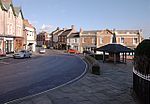Calke
Civil parishes in DerbyshireDerbyshire geography stubsSouth Derbyshire DistrictUse British English from November 2023Villages in Derbyshire

Calke is a small village and civil parish in the South Derbyshire district of Derbyshire, England. It includes the historic house Calke Abbey, a National Trust property, although the main entrance to its grounds is from the neighbouring village of Ticknall, where the population of Calke is included. The settlement name Calke means "calc" (Anglian) Chalk, lime, limestone. Results from the 2011 census shows Calke to contain around 10 households with a population of about 24.
Excerpt from the Wikipedia article Calke (License: CC BY-SA 3.0, Authors, Images).Calke
South Derbyshire
Geographical coordinates (GPS) Address Nearby Places Show on map
Geographical coordinates (GPS)
| Latitude | Longitude |
|---|---|
| N 52.795 ° | E -1.448 ° |
Address
LE65 1RR South Derbyshire
England, United Kingdom
Open on Google Maps









